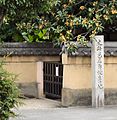Matsuo Basho facts for kids

Matsuo Bashō (born Matsuo Munefusa, 1644 – November 28, 1694) was a famous Japanese poet. He is known as the greatest writer of haiku, a special type of poem with 17 syllables. Bashō's haikus often described nature and the four seasons. To understand his poems, readers needed to use their imagination.
In Japan, it was common to call him just Basho, without his family name. He was one of the most important writers during the Edo period in Japan. He helped make haiku a very respected form of poetry.
Contents
Who Was Matsuo Bashō?
Bashō was born in 1644 in Iga, which is now part of Mie Prefecture. His family were samurai, who were Japanese warriors. For many years, he lived the life of a samurai. However, he later decided that writing poetry was what he truly wanted to do. So, he stopped being a samurai to focus on poetry.
Bashō learned a lot about classic Japanese poems. When he first started writing, he called himself Tosei, which means "unripe peach in blue". He chose this name because he admired a Chinese poet named Li Po. Li Po's name means "plum in white".
Bashō's Life in Edo
In 1666, Bashō left his samurai life. In 1675, he moved to Edo, which is what Tokyo is called today. By 1678, he became a haiku master, known as a "Sosho". This meant he could make a living as a poet.
In 1680, he moved to a house in Fukagawa, just outside Edo. One of his students gave him a banana plant. Bashō loved this plant so much that he planted it in his garden. He then decided to call himself Basho, which is the Japanese word for banana plant.
Bashō's Travels and Writings
Bashō traveled to many different places during his life. These journeys were very important for his writing. He visited his students and taught them by creating renga with them. Renga is a series of linked haiku poems. He also visited famous historical places in Japan. These visits made his writing much stronger and deeper.
His most famous book is Oku no Hosomichi, which means "The Narrow Road Through the Deep North". He wrote this book after a long trip. Bashō and one of his students left Edo on March 24, 1689. They traveled through areas like Tohoku and Hokuriku. They returned to Edo in 1691. The journey described in the book ends in Ogaki, which is now part of Gifu Prefecture. In the book, Bashō wrote a haiku that hinted he wanted to visit Ise Shrine after staying in Ogaki. Many people believe Bashō wrote some of the most beautiful travel diaries in Japanese history.
Bashō's Final Days
Bashō became sick and passed away in early autumn of 1694. He was in Osaka, staying at a student's house during a trip. Before he died, he wrote one last haiku:
- Tabini yande / yume ha kareno wo / kake meguru
- On travel I am sick
- My dream is running around
- a field covered with dried grass
Images for kids
-
Bashō's supposed birthplace in Iga Province.
-
Bashō meets two farmers celebrating the mid-autumn moon festival in a print from Yoshitoshi's Hundred Aspects of the Moon. The haiku reads: "Since the crescent moon, I have been waiting for tonight."
-
Bashō's grave in Ōtsu, Shiga Prefecture
-
"Bashō's Hermitage and Camellia Hill on the Kanda Aqueduct at Sekiguchi" from Hiroshige's One Hundred Famous Views of Edo
See also
 In Spanish: D Matsuo Bashō para niños
In Spanish: D Matsuo Bashō para niños







